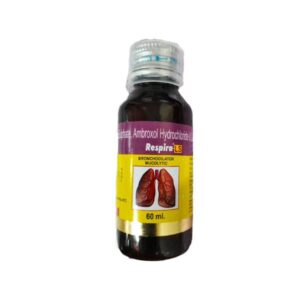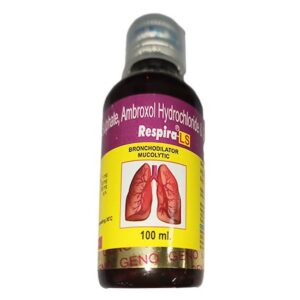AMBROXOL + SALBUTAMOL + GUAIPHENESIN
Ambroxol: Ambroxol is a medication commonly used as a mucolytic agent, which means it helps to break down and thin mucus in the airways. It is primarily used to treat respiratory conditions such as bronchitis, chronic obstructive pulmonary disease (COPD), and asthma.
The mechanism of action of Ambroxol involves increasing the production and secretion of thin mucus in the airways. It also enhances the activity of enzymes that help break down thick mucus, making it easier to expel. Additionally, Ambroxol has been found to have anti-inflammatory and antioxidant effects, which can further benefit respiratory conditions.
The usual dose of Ambroxol is 30 mg taken orally three times a day for adults and adolescents over 12 years old. For younger children, the dose is adjusted based on their weight. It is available in various forms, including tablets, syrup, and oral solution.
While Ambroxol is generally well-tolerated, some common side effects may include gastrointestinal symptoms such as nausea, vomiting, abdominal pain, and diarrhea. These side effects are usually mild and transient. Rarely, allergic reactions may occur, characterized by rash, itching, swelling, or difficulty breathing. If any severe or concerning side effects occur, it is important to seek medical attention.
It is worth noting that Ambroxol may interact with certain medications, so it is essential to inform your healthcare provider about any other medications you are taking to avoid potential drug interactions.
In summary, Ambroxol is a mucolytic drug used to break down and thin mucus in respiratory conditions such as bronchitis, COPD, and asthma. It works by increasing mucus production and secretion while also aiding in the breakdown of thick mucus. The usual dose is 30 mg three times a day, and side effects are generally mild and transient.
Salbutamol: Salbutamol is a medication commonly used to treat respiratory conditions such as asthma and chronic obstructive pulmonary disease (COPD). It belongs to a class of drugs called beta-2 adrenergic agonists.
The primary mechanism of action of salbutamol is to act on the beta-2 receptors in the smooth muscles of the airways, leading to their relaxation. This action helps to widen the airways and facilitates easier breathing. It also has a minor effect on the beta-1 receptors in the heart, which can cause an increased heart rate.
Salbutamol is available in various forms, including inhalers (metered-dose inhaler, dry powder inhaler) and oral tablets. The dose and frequency of administration may vary depending on the formulation and the individual’s condition.
For the treatment of asthma, the usual starting dose for adults is 100-200 micrograms (mcg) administered using an inhaler. The dose may be repeated every 4-6 hours as needed. For acute asthma attacks, higher doses may be required. The maximum daily dose is typically 800 mcg.
Common side effects of salbutamol may include tremors or shakiness, headache, increased heart rate, palpitations, muscle cramps, and nausea. These side effects are usually mild and temporary. In some cases, salbutamol may also cause allergic reactions, chest pain, or irregular heartbeat, and it is important to seek medical attention if such symptoms occur.
It is worth noting that the use of salbutamol alone may not be sufficient for the management of severe respiratory conditions, and it is often used in combination with other medications, such as corticosteroids, for optimal control of symptoms. It is always recommended to follow the prescribed dosage and consult with a healthcare professional for personalized advice.
Guaiphenesin: Drug: Guaifenesin
Use: Guaifenesin is an expectorant commonly used to relieve chest congestion caused by the common cold, bronchitis, and other respiratory tract infections. It helps to loosen and thin mucus in the airways, making coughing more productive.
Mechanism of Action: The exact mechanism of action of guaifenesin is not fully understood. However, it is believed to work by increasing the volume and reducing the viscosity of respiratory tract secretions, which helps to facilitate their removal from the lungs. This action helps to alleviate congestion and promote easier breathing.
Dose: The recommended dose of guaifenesin for adults and children above 12 years of age is usually 200-400mg orally every 4 to 6 hours, not exceeding 2.4 grams per day. It is essential to carefully follow the dosage instructions provided by your healthcare provider or as directed on the product label.
Side Effects: Guaifenesin is generally well-tolerated, and most individuals do not experience any significant side effects. However, some common side effects that may occur include:
1. Nausea
2. Vomiting
3. Upset stomach
4. Diarrhea
5. Dizziness
6. Headache
If you experience any severe or persistent side effects or an allergic reaction (difficulty breathing, rash, swelling), it is important to seek immediate medical attention.
Please note that this is a general overview of guaifenesin, and it is always advisable to consult a healthcare professional for specific dosage instructions and to address any concerns or questions you may have.


